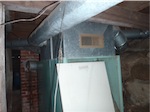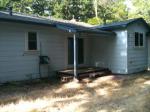My story started six years ago in Moraga, California. All was well. The kids were out of the house, two on their own and one in college. Work was good. All the saving and planning was paying off. We had saved enough to do the kitchen remodel that we planned years for. With me doing the demolition, we had just enough to build our dream kitchen. We wanted to make it energy efficient but not at a cost to us. It was 2006, the markets would continue to go up and we would get around to doing what was right for the environment once our wishes had been fulfilled.
Other than the normal issues with cost adjustments and specific design issues, the work went well over the five-month project. Or at least we thought so. We had a beautiful new kitchen, except the inspection for the building permit failed due to electrical defects. We enjoyed the kitchen for three months as we tried but failed to get the contractor to repair the defects.
Then, early in June, I left for work 15 minutes after my wife. I made sure to turn off the lights and lock things up. It was a normal day until 1:30 P.M. when I got a call from a neighbor that my house was on fire and get home ASAP! I arrived at the scene the same time as my wife. From the smoke and the six fire trucks, it was obvious that this was not a small fire. As we walked to the house to inspect the damage we knew that no one had been hurt and agreed that whatever we lost were just things. We had enough insurance and we would be fine.
As we would find out, the last thing you want is a half of a fire. We were lucky, it was a full fire. Poor electrical work above the kitchen had set the attic on fire. A contractor doing work around the corner had smelled smoke at about 10 A.M. but didn’t see anything. The fire continued for another 3 hours until it burst through the roof at 1:15 P.M. With the dry, 40 year old wood shingles, it roared to life in seconds. When it was over, the roof had collapsed in on the house. Again, we were lucky. The firemen had tarped some irreplaceable furniture as they fought the fire. China and photo albums were mostly unharmed in the cupboards close to the floor.
We now had the opportunity to rebuild the entire house how we wanted. And what we wanted was an energy efficient house. Instead of a tragedy, we saw this as an opportunity. The insurance company found us several contractors that they preferred, and we selected one that we felt we could work with.
The first thing we did was to tell the contractor that we intended to install solar power. He put us in contact with a company that would do the installation. But how much would we need? I retrieved the old power bills from storage and found that over the previous two years we had averaged 12,000 Kilowatt-hours a year. We thought we could cut this by 25 percent with other energy efficient products, so I settled for a system that would average 9,000 kilowatt-hours a year. The house was southwest facing in the back. Would that be a problem? No, it was good for where we lived. The system would cost $65,000, of which $25,000 paid through state and federal credits and $40,000 from us. Expensive, right? Not if you consider that the system had a warranty for 20 years and at the current cost of electricity it would pay for itself over 12 years. At 20 years it would give us a return on investment of 8%, better that any bond we could buy. Expensive in the short term but a bargain in the long term.
The roof now had to carry the load of the solar panels and we were considering concrete tiles. The weight would require machined trusses instead of an ordinary roof. Would this be expensive? No, the trusses were more efficient and cost less than a normal roof and the concrete tiles were substantially less than the cedar shingles. Since we would now have a fire retardant roof, why not the siding as well. There is a product called Hardee Board that looks like wood siding but is made from concrete. It was more expensive, about 25%, but gave us an unexpected benefit. Our first insurance bill had gone down by a third because we live in fire country and the house was now fire resistant.
As we built our dream house out of the ashes of our dream kitchen, we continued to make it as energy efficient as possible. We installed four-pin compact fluorescent can lighting throughout the house, at the same cost as replacing the old lighting. We added energy efficient fireplaces designed similar to wood stoves that use air from the outside to heat, and meet all current fire particle emission standards. The two fireplaces were double the cost of conventional fireplaces but provide wonderful radiant heat. We converted all accent lighting to LED bulbs. LED lights are still very expensive, but the costs are slowly coming down. We installed adequate insulation, R-30 in the attic and R-13 in the walls, and made sure we had quality finishing with the windows and doors.
We still needed to order the water heater. We could go with the standard American version which wastes space and is a waste of energy, or opt for a flash water heater. The gas version is efficient but given that the location for the water heater is in the middle of the house, we would need to vent it with a new hole in the roof. We could go with electric, but wouldn’t that be expensive? As we were looking at our electrical use, we discovered another very important piece of information. I had calculated my energy production from solar to completely offset our use. But to qualify for the credits, we had to be connected to the grid and not use batteries. Energy costs for daylight use is much more expensive than for evenings and nights and solar generates electricity during the daylight hours. You don’t need to offset all of your power needs to reduce your power bill to zero. So we had enough energy production to go with an electric water heater. The price of a conventional 40-gallon gas water heater was $665 plus $66 for instillation. The electric flash water heater was $585 on the internet and because of the electrical connections, cost $600 to install.
Few people seem to realize that solar power provides a secondary benefit. Not only does it offset conventional energy production, it offsets the add-on generation used for peak load times. The plants used for this purpose are generally the least efficient and dirtiest plants available. Solar installation provides for leveling of the production process and greatly reduces pollution.
My annual true-up bill from the electric utility has been a credit of $410 for 2007, a cost of $33.79 for 2008, a cost of $29.39 for 2009, a cost of $163.89 for 2010 and a cost of $116.88 for 2011. This is with the electric water heater, as well as the 18 year old electric hot tub in the back. The electricity also helps power a Prius with a 4-kilowatt plug in conversion kit that gets upwards of 80 MPG around town.
Our disaster has led us to a life style change with the reward of a new way of looking at how we live and how we use energy. Our current way of life is not diminished but instead has been greatly enhanced.
Robert Susich is a Certified Public Accountant providing tax and financial services to individuals and businesses. He can be reached at RSusich@MSN.com or by telephone at (925) 367-6536.








